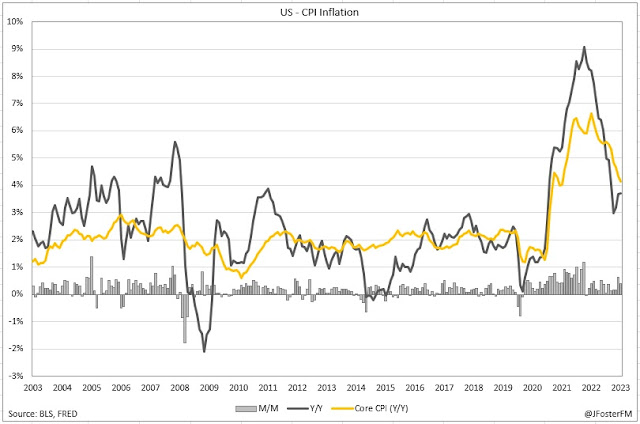Despite headwinds in the US Treasury market, the 10-year benchmark yield fell substantially this week on indications the Fed's tightening cycle has reached its peak. Equity performances were patchy across regions while geopolitical factors led to US dollar support. The IMF's latest World Economic Outlook forecasts that global growth - while slowing - will stay resilient this year (3%) and next (2.9%), drawing out the return of inflation to many central banks' targets until 2025.
Commentary from a host of Fed officials during the week indicating higher bond yields can substitute for additional monetary policy tightening outweighed a mildly disappointing US inflation report. Headline CPI remained at a 3.7% year-on-year pace (vs 3.6% consensus) - up from its recent low of 3% in June with petrol prices surging by around 13% since then - while the core rate eased from 4.3% to 4.1%yr (as expected). Alongside higher petrol prices, rents (7.2%) remain a major driver of inflation. Removing these effects (and other volatile items), the underlying dynamic persists of core services inflation (2.8%yr) continuing to be much more elevated than core goods inflation, which eased to a 30-month low (1.6%yr). While now largely dated by the week's events, the FOMC's September meeting minutes conveyed there was already a degree of caution around the policy outlook. The prospect of further tightening hinged on the incoming data, though "all participants" had agreed that rates would need to "remain restrictive for some time".
Assessments that the ECB's mid-September rate hike may have brought policy rates to their cycle peaks appeared to be largely validated by the account of the meeting. While the Governing Council elected to hike by 25bps, the decision was characterised as a "close call" as strong consideration was given to a tightening pause. Notably, there was "ample evidence" that the strength of monetary policy transmission to the real economy - a key part of the Governing Council's reaction function - was "proceeding strongly, more so than expected". Whereas the ECB's tightening cycle had been driven by the view that under-tightening presented greater economic risks than over-tightening, the Governing Council judged that at their current levels (depo rate 4%) these risks were now closer to being in balance. It also judged that - if maintained - rates should be at levels that are consistent with inflation falling back to the 2% target.
Data in Australia was limited to second-tier releases this week that reaffirmed existing themes. The Westpac-Melbourne Institute Index improved by 2.9% in October but still remains at deeply pessimistic levels, mainly reflecting cost-of-living pressures. For businesses, the NAB Survey reported confidence among firms remained weak in September (+1); however, that belies an ongoing resilience in business conditions that remain above average (+11). A speech from RBA Assistant Governor Kent unpacked the various channels by which tighter monetary policy was working through the economy. The observation that the full effects on demand and, in turn, inflation were still in the pipeline appears consistent with the Board's tightening pause.



